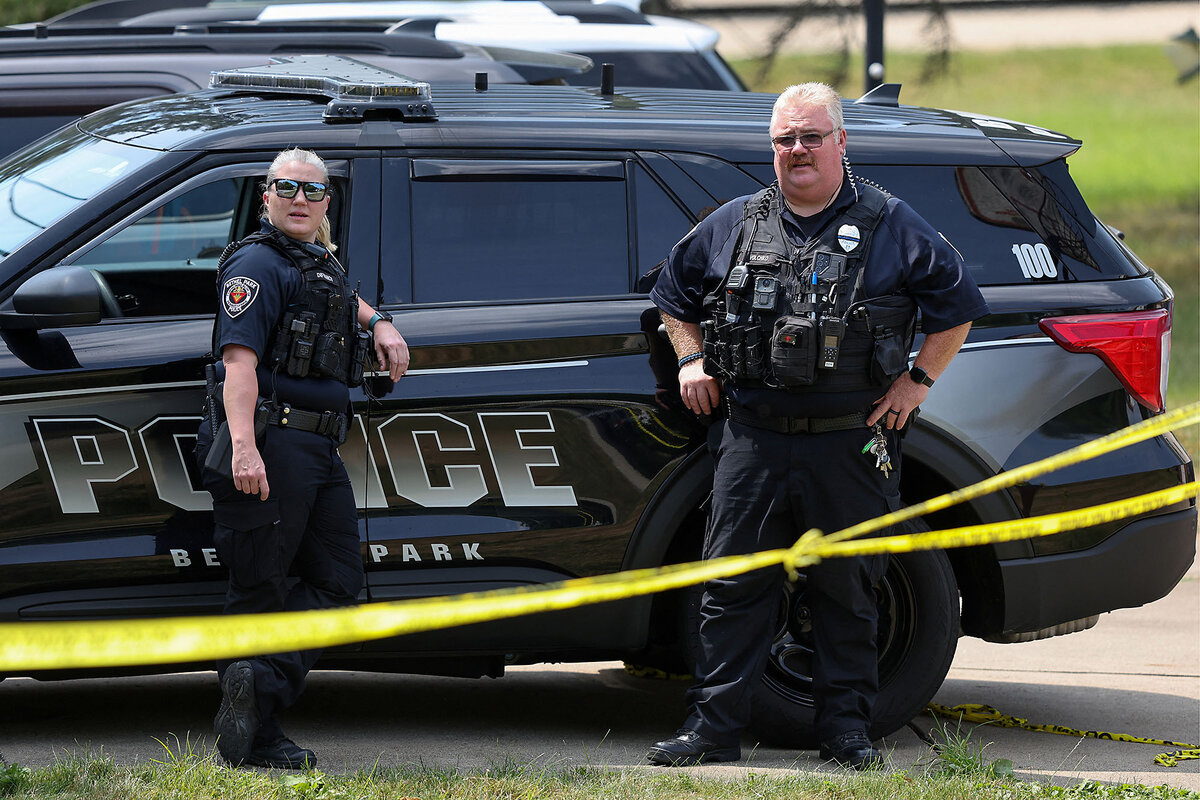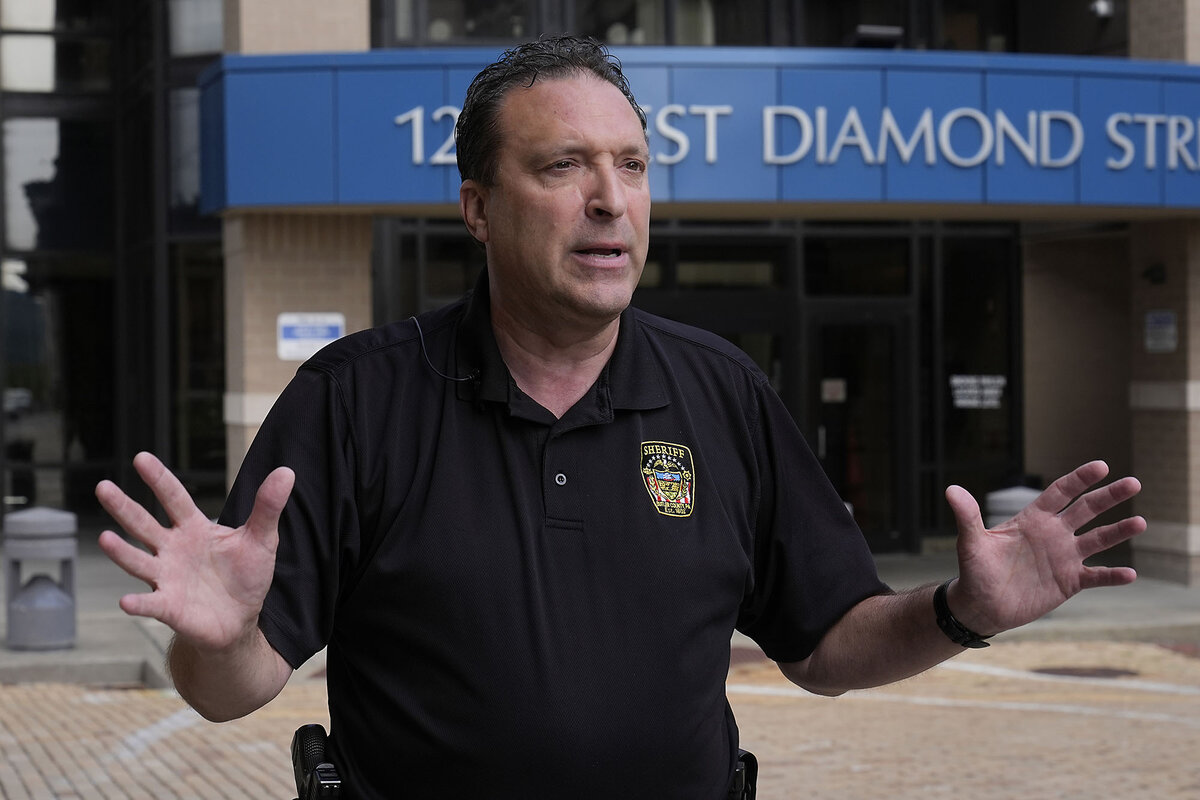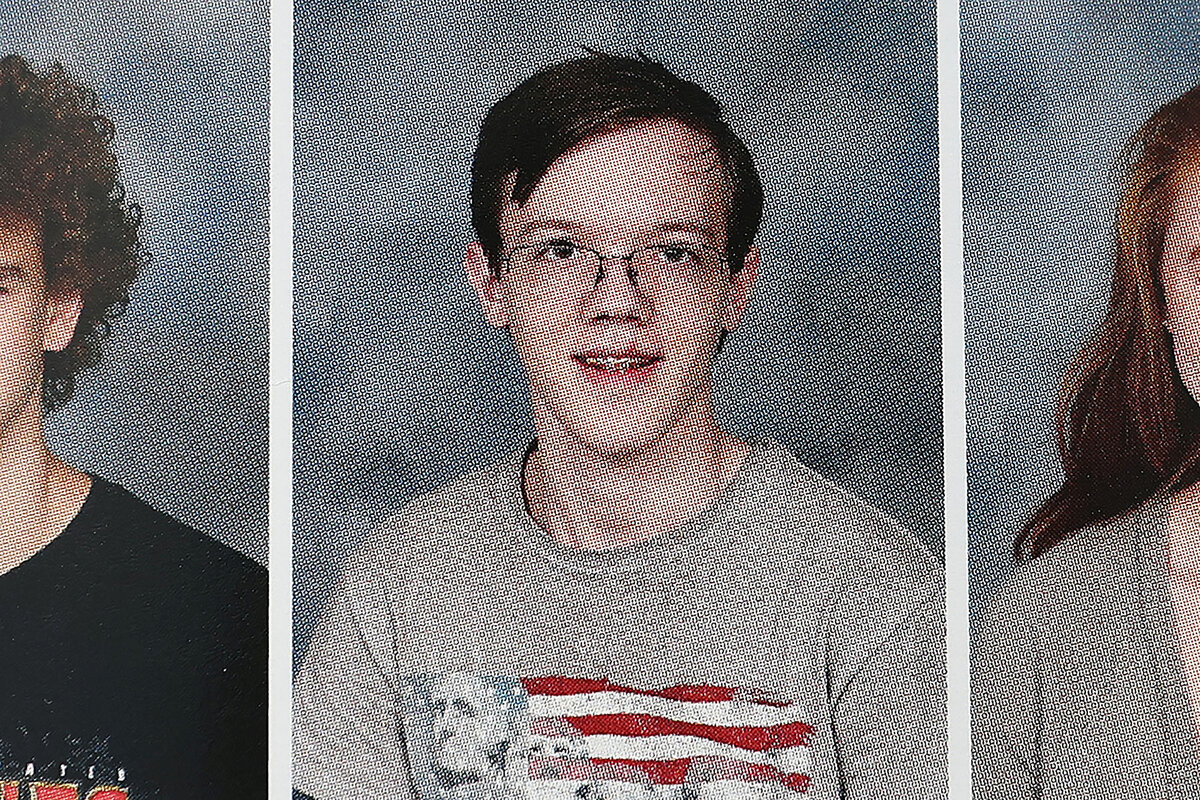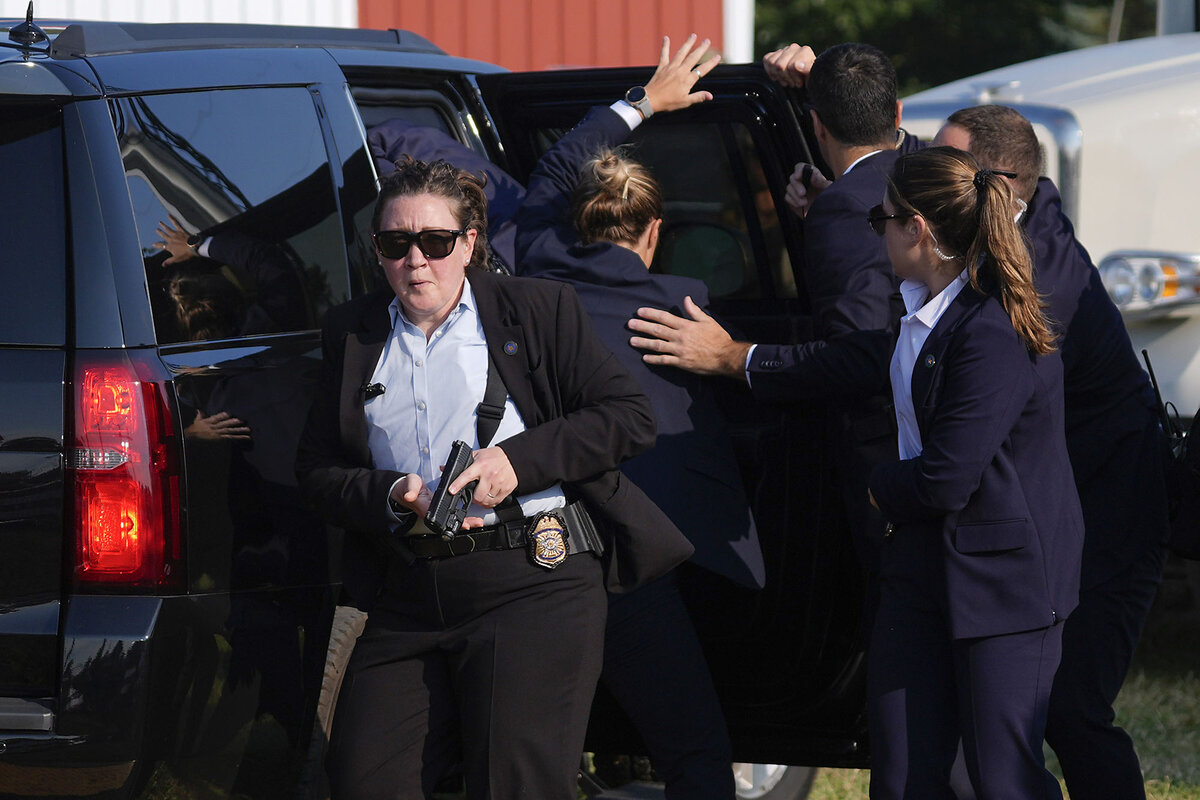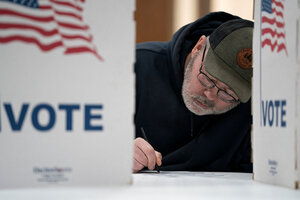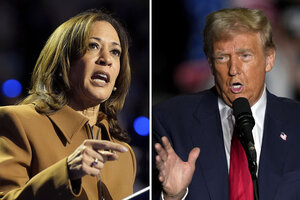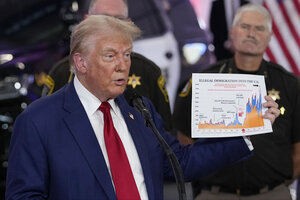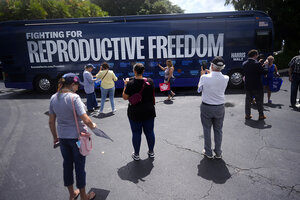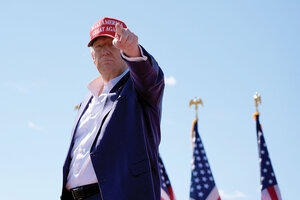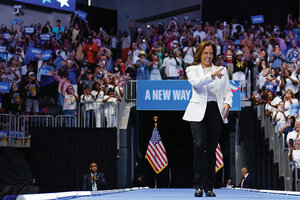From Pennsylvania to Capitol Hill, a push for answers on Secret Service lapse
Loading...
| Butler, Pa.; and Washington
Preparations were in full swing for former President Donald Trump’s rally at the Butler Farm Show grounds when Mitchel Delullo pulled up with two giant cranes.
As he hoisted a massive U.S. flag, the rental equipment provider and Trump supporter felt proud to be a part of something bigger than himself. The event ended up being big in a way he never could have imagined.
The next day, Mr. Delullo was in the crowd behind Mr. Trump when shots rang out.
Why We Wrote This
Security lapses that enabled the July 13 shooting of former President Donald Trump are raising larger questions about Secret Service protection – prompting bipartisan calls today for the director’s resignation.
What followed nearly altered the course of a historic election season. The July 13 shooting – which injured Mr. Trump’s ear, killed a former fire chief, and put two other rallygoers in the hospital – has also let loose an avalanche of finger-pointing and recriminations.
On Monday, Congress held its first hearing to try to piece together how a lone shooter got so close to assassinating a former president under protection by the Secret Service. The egregious lapse, which resulted in the first shooting of a current or former president in more than 40 years, has left even eyewitnesses incredulous.
“I was there, and I’m still trying to figure out the truth,” Mr. Delullo says. “A 20-year-old kid with no military experience was able to outsmart one of the smartest teams in the world.”
The shooter positioned himself on an unpatrolled roof within easy rifle range of the stage where Mr. Trump would appear. The roof, despite offering a high vantage point and clear line of sight to the stage, was deemed outside the security perimeter of the event. According to Secret Service Director Kimberly Cheatle, the shooter was about 200 yards away from the former president. Yet his AR-15, a weapon commonly used in U.S. mass shootings over the past 15 years, had a range of 400 to 600 meters.
Questions range from the motives of the shooter (still unknown) to the security planning, staffing, and performance of the Secret Service and local law enforcement. Most pressing is why the roof was not patrolled and why Mr. Trump’s detail allowed him to take the stage despite numerous red flags.
Ms. Cheatle, who complied with a subpoena to appear before the House Oversight committee Monday morning, has taken the most heat. The agency has a $3.1 billion annual budget, 8,000 personnel, and a “zero-fail” mission. Yet even by her admission, it failed July 13.
Director Cheatle faced a bipartisan grilling at Monday’s hearing. Ranking member Jamie Raskin called the near assassination of Mr. Trump a “stunning security failure” in his opening remarks. By the end of the hearing, during which it became evident Ms. Cheatle had failed to regain the confidence of lawmakers by demonstrating transparency and cooperation, Mr. Raskin joined Republican Chair James Comer in urging her to resign.
Ms. Cheatle resigned the following morning.
But simply removing Ms. Cheatle without methodically piecing together what went wrong at the tactical level will not solve the problem, says Steven Rotkoff, a retired U.S. Army colonel who runs his own company – Red Team Rotkoff – helping organizations game out their security planning.
“If all they do is crucify her, then the system has failed and the Secret Service has failed,” says Mr. Rotkoff, who served on a commission recommending security improvements to Congress after the Jan. 6, 2021, Capitol riots.
At stake, he says, is not only protecting presidents but also ensuring that security concerns do not significantly narrow the field of politics.
“If we cannot do a good job of guaranteeing security of the people who run for office in America, then quality people will not run,” he says, underscoring the need to keep any investigations nonpolitical. “Everybody should be invested.”
Local views of a vulnerable venue
Butler County, a mostly white, working-class area north of Pittsburgh, dotted with churches and fading mid-century homes, is a Trump stronghold in a key swing state. Mr. Trump rallied in Butler just days before the 2020 election and won the area with 66% of the vote despite losing the state to Joe Biden. That rally took place at the local airport, which was unavailable this time because of a previously planned event.
The piercing of a protective wall for a major U.S. candidate hit particularly hard for local Trump rally volunteers.
Butler County Emergency Management Director Steven Bicehouse was about 40 yards from Mr. Trump, tending to a heat-stricken attendee, when the shots rang out.
“We very quickly changed gears and treated the gunshot victims immediately,” says Mr. Bicehouse, saying he had limited interaction with Mr. Trump’s planning team. “We didn’t have time for emotion until later when the job was done.”
This weekend, dozens of survivors regrouped at the Snack-n-Pack restaurant in Butler to discuss what happened. Among them was Zach Scherer, a firefighter from nearby Chicora, Pennsylvania, who has been to some 20 Trump rallies and has visited the former president at Mar-a-Lago.
When Mr. Scherer arrived on Friday evening to look at preparations, he was stunned that he was able to drive his truck onto the grounds and park by the stage. Most events, he says, are locked down 36 hours before anyone takes the stage. “I wasn’t searched, I wasn’t vetted, I could have planted any type of device.”
The venue, he adds, was a poor choice, estimating that it has “probably 20” entrances. “There’s no way in hell to lock down that entire place,” he says.
Mr. Scherer also noted the lack of what he had seen at other Trump events – a private security team. He says he raised his concerns to organizers.
“There are so many questions. I don’t know whether it falls back on the state party, on the organizational side of things, or whether it falls back on federal law enforcement,” he says. “And then everyone you talk to is saying our local police were responsible for outside the perimeter. There are so many fingers being pointed.”
Gaps in security at Butler rally
Director Cheatle had said in an interview with ABC News that local law enforcement were responsible for the building where the shooter perched, though she clarified at the hearing that none of her comments should be construed to blame them.
Local officials, for their part, have said they informed the Secret Service two days before the rally that they didn’t have the staffing to cover that rooftop.
One local law enforcement agent, speaking on condition of anonymity because he didn’t have authority to speak publicly, confirmed to the Monitor that local police had a limited role. He said the two officers who were able to confront the shooter moments before he fired had been pulled off traffic duty to look for a suspicious man who had been reported.
His name was Thomas Matthew Crooks of Bethel Park, a Pittsburgh suburb where school district officials said he “excelled academically” and generally got along with others. He went on to get an associate’s degree in engineering. “He was extremely intelligent,” says Kev Man, who runs a Pittsburgh hot sauce company and whose son attended high school with the shooter.
According to Butler officials, one of the local police officers made eye contact with Mr. Crooks after getting hoisted up to the roof’s edge but then, after the shooter pointed his gun at him, let go – falling and hurting his leg. Butler County Sheriff Mike Slupe has hailed that man as a hero who potentially saved Mr. Trump’s life by distracting the shooter.
No law enforcement personnel were posted on that roof, though some were reportedly inside the building. Ms. Cheatle told ABC News that was because of the roof’s slope, though others have pointed out that counter-snipers were stationed on a steeper roof. She confirmed that a Secret Service agent killed the shooter almost immediately after he opened fire.
Over the past week, other key gaps in the event’s security have come to light. The shooter surveyed the area with a drone hours before the event, The Wall Street Journal reported. However, the Secret Service, which according to a 2023 government report employs drones to “create secure environments for protected people, places, and events,” reportedly did not use aerial surveillance.
The Secret Service had initially refuted claims that leadership had denied requests from Mr. Trump and his team for more protection, but the Washington Post reported Friday that the agency had in fact repeatedly denied such requests.
According to a July 20 letter to Director Cheatle from GOP Sen. Chuck Grassley of Iowa, Mr. Trump received only three Secret Service “post-standers” – agents assigned to specific posts at a venue – for his rally, which drew an estimated 20,000 people, according to a local GOP campaign aide. By comparison, First Lady Jill Biden received 12 in Pittsburgh the same day. Senator Grassley, known for his dogged investigations over 44 years in Congress, cited whistleblowers as his source.
Ms. Cheatle would not give specific numbers of how many agents were deployed to the rally, saying only that all “assets” requested by Mr. Trump’s team for that day were granted.
Time line and alleged communication failures
GOP Sen. Ron Johnson of Wisconsin, ranking member of the Senate Homeland Security Committee, has also investigated – reaching out to state and local officials, among others. His office’s interim report found that Secret Service did not attend a briefing with law enforcement the morning of the Butler rally, and communications were siloed among the various partner agencies.
Despite the difficulty in alerting all law enforcement simultaneously of a threat, Secret Service was notified of Mr. Crooks’ suspicious behavior with plenty of time to act, according to the report.
The sniper first observed Mr. Crooks at 5:10 p.m., just over an hour before the shooting; took at least two photos of him at 5:14 p.m., and then shortly after 5:30 p.m. sent a group text to other snipers and then reported to “command” at 5:41 the suspect’s appearance and possession of a range finder, which pinpoints the distance between shooter and target so sights can be set accurately.
By 5:59 p.m., 13 minutes before the shooting, local law enforcement had received confirmation that the Secret Service was aware of the alert, the report says. Democrat Rep. Melanie Stansbury of New Mexico said at the hearing they knew by 5:51 p.m. Yet Secret Service agents still allowed Mr. Trump to approach the stage at 6:03.
Mr. Trump told Fox News in an interview that will air in full Monday night that he was never alerted to a possible threat before taking the stage.
Bystanders shouted to law enforcement approximately two minutes before the shooting at 6:11 p.m. that there was a man with a gun crawling atop an unpatrolled roof within easy rifle range of the podium.
Throughout the Oversight hearing, Ms. Cheatle repeatedly drew a distinction between identifying a suspicious person and a threat, the latter of which occurred less than five minutes before the shooting.
Ms. Cheatle confirmed that it was a Secret Service agent who killed the shooter after he opened fire. She said there was “overwatch” of the roof, without specifying from where. She said the agency is putting together a comprehensive report so that she could identify exactly where the “gaps and failures” occurred.
Bipartisan frustration with the Secret Service
The Department of Homeland Security has announced an independent panel to investigate what went wrong. U.S. lawmakers are also moving quickly to get answers.
While the Oversight committee was conducting its nearly five-hour hearing Monday, members of the House Homeland Security committee were in Butler touring the rally grounds ahead of a slated hearing on Tuesday.
Oversight committee members from both sides of the aisle grew agitated with Ms. Cheatle and her inability or unwillingness to answer basic questions.
GOP Rep. Michael Cloud of Texas said it was “very, very troubling” that Ms. Cheatle was unable to provide any answers, nine days after the shooting, about the “No. 1 question:” why the roof was left unpatrolled.
Ms. Cheatle said she expected results of an internal investigation within about 60 days, though she clarified she was not waiting for any reports before taking appropriate corrective measures.
Democratic Rep. Alexandria Ocasio-Cortez of New York said that timeframe was “unacceptable” given the heightened threat environment leading up to a consequential election, and the potential for a successful attack to spark more political violence.
“The stakes are too high,” she said.
Editor’s note: This story was updated to reflect Ms. Cheatle’s resignation on Tuesday, July 23.








